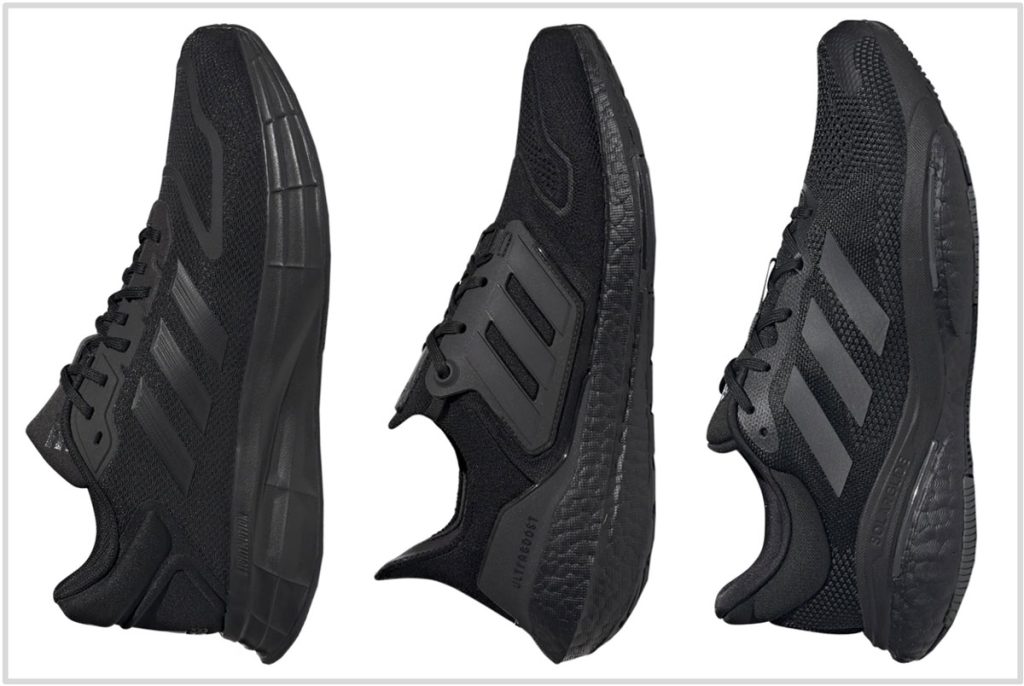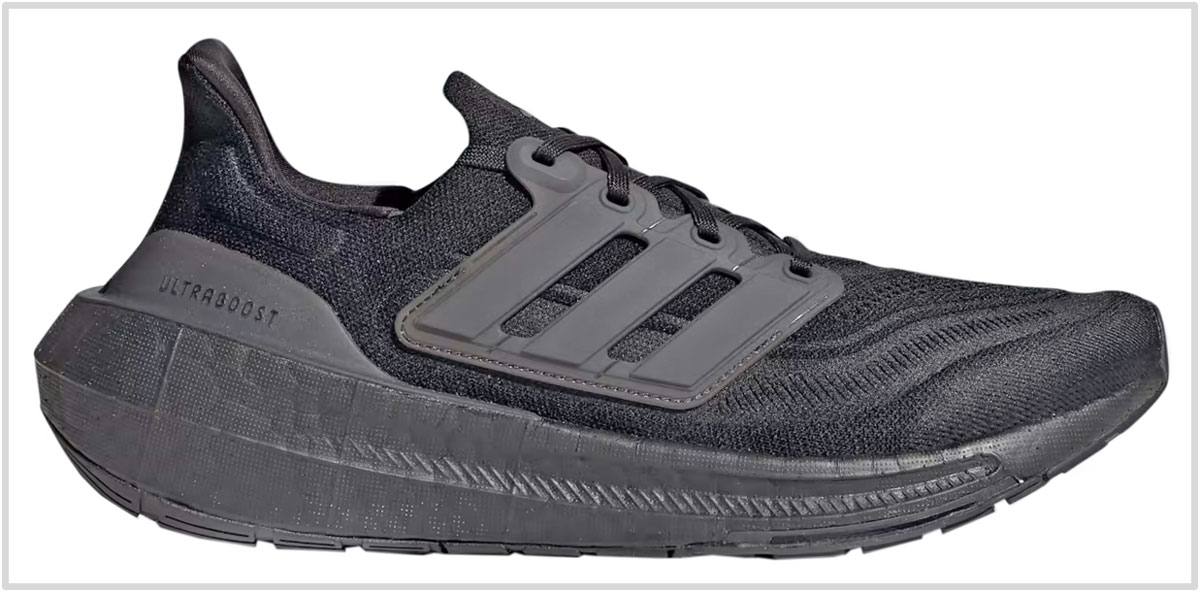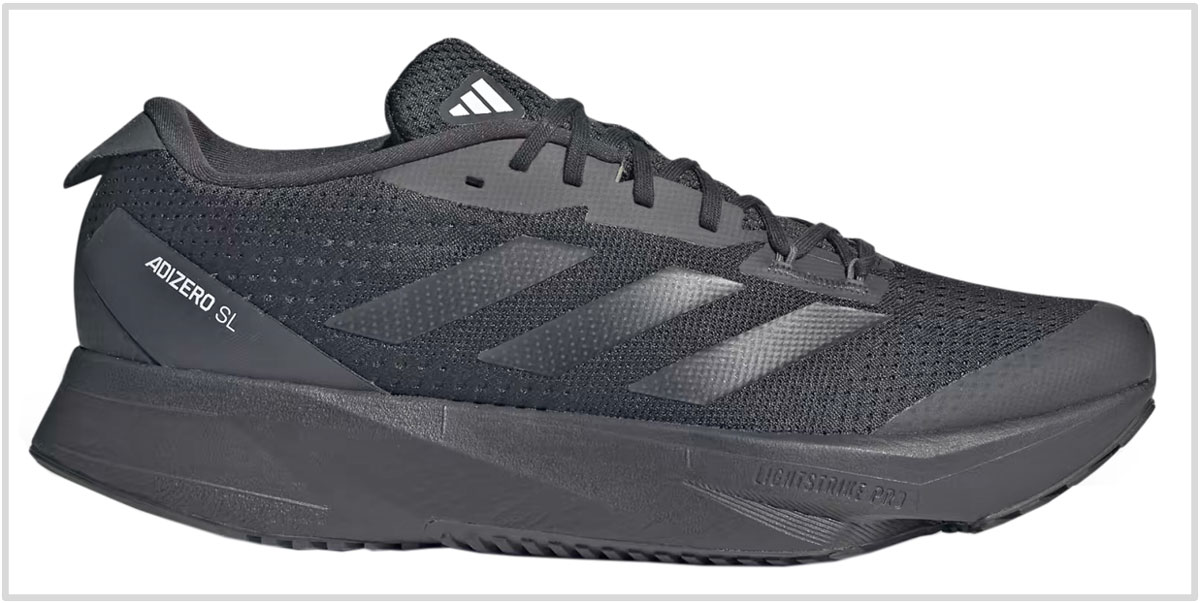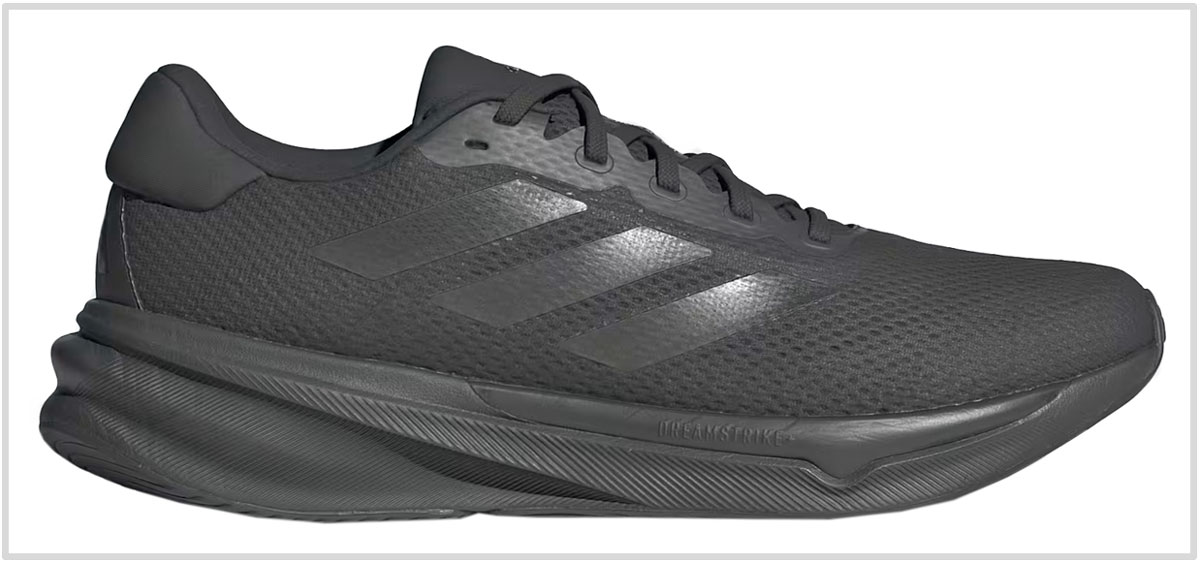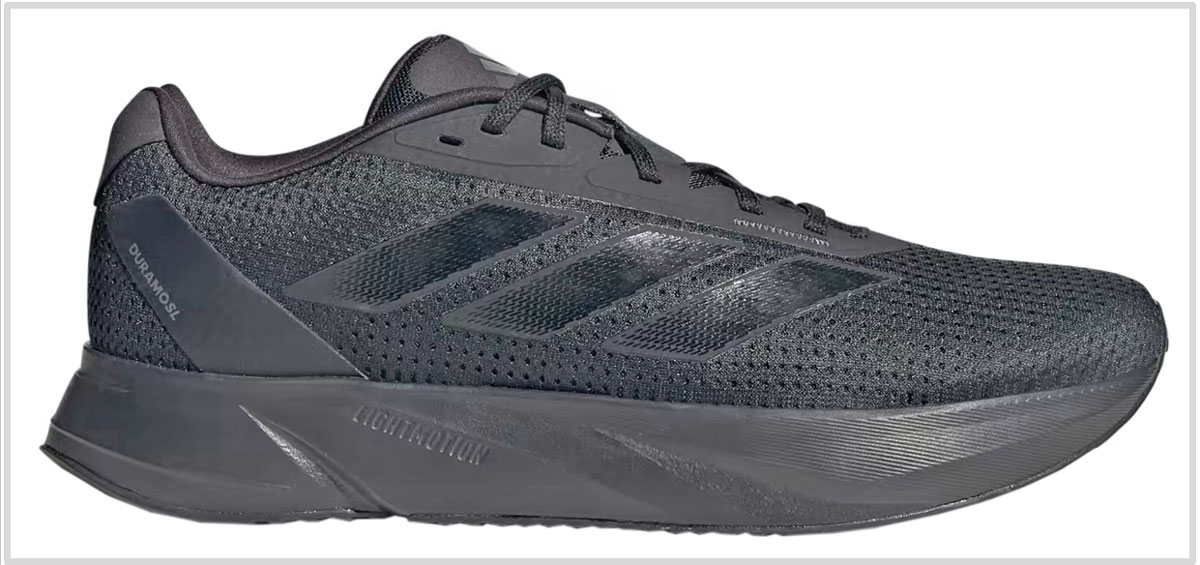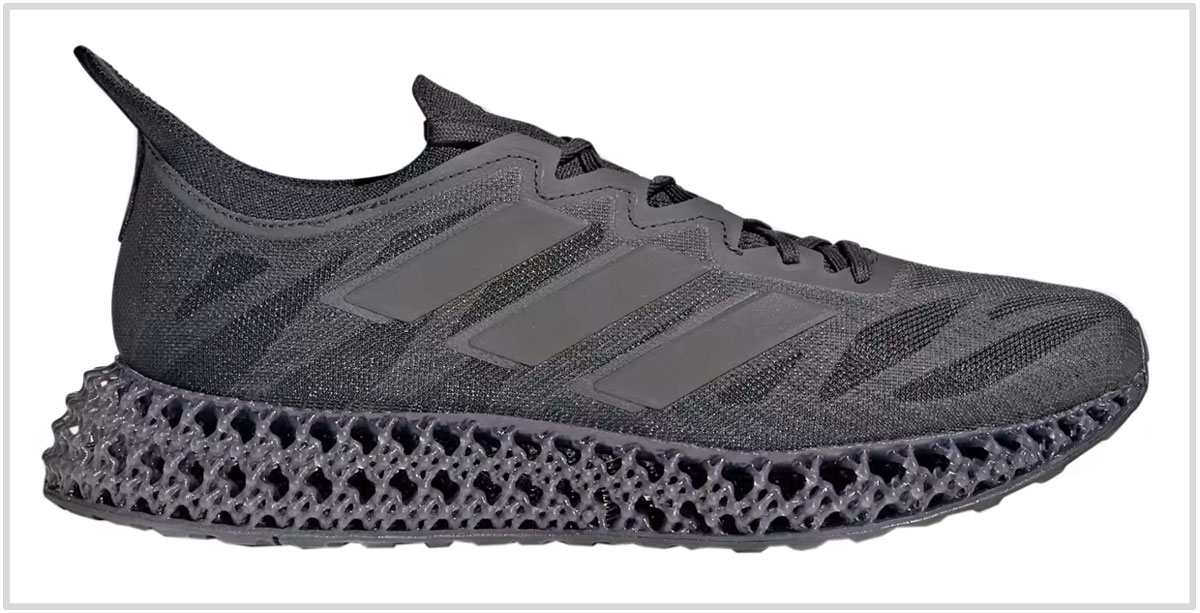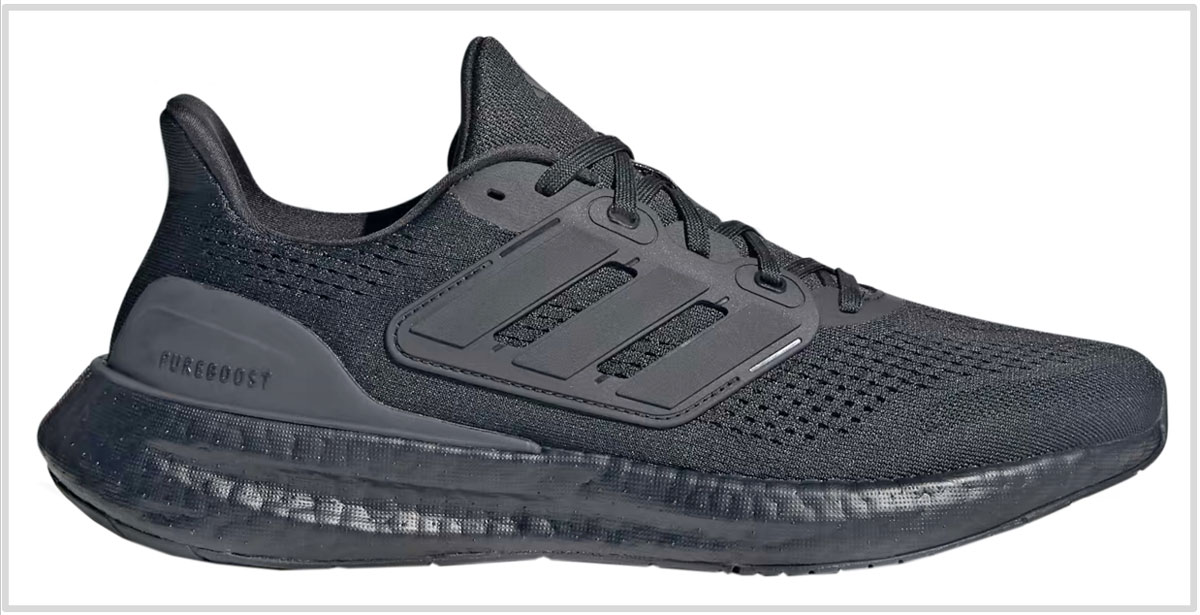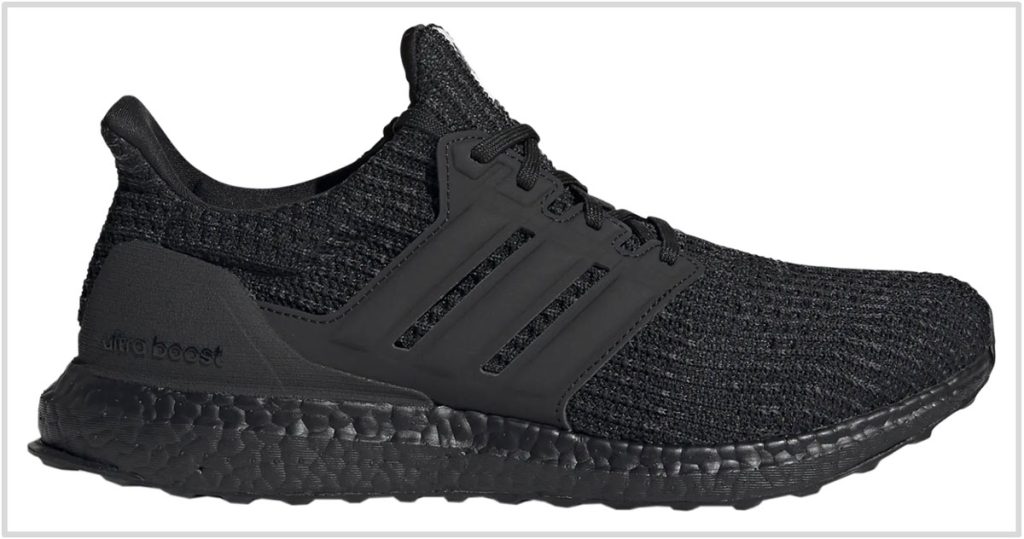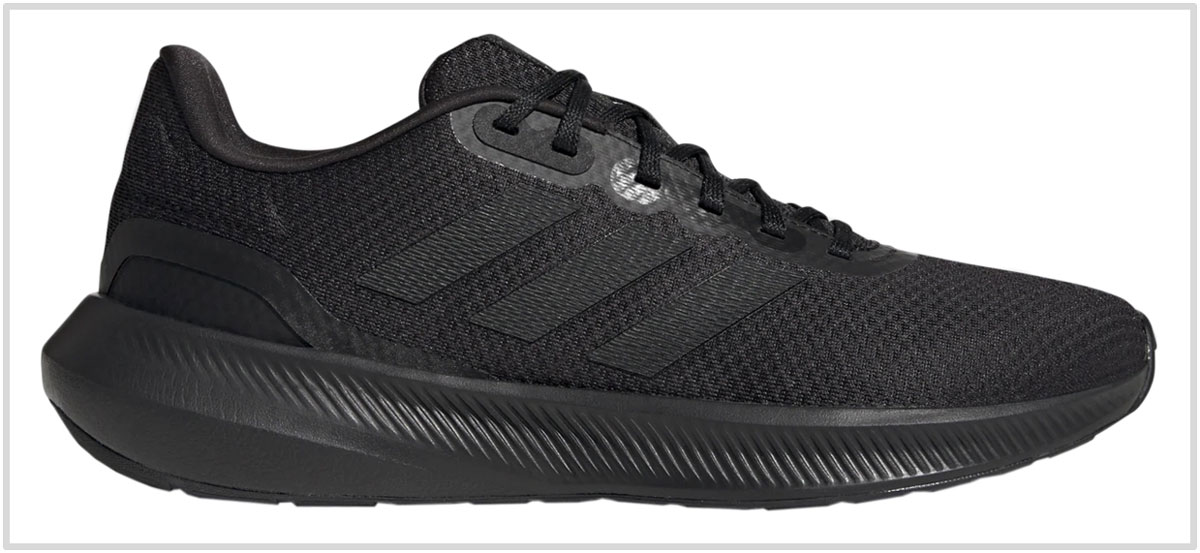This article has been updated with current models for March 2024. Most of the shoes on this guide have been replaced with their updated versions.
In this product guide:
- 1. Factors to consider
- 2. Our top pick: adidas Ultraboost Light
- 3. Cushioned tempo trainer: adidas adizero SL
- 4. Everyday neutral trainer: adidas Supernova Stride
- 5. Our top budget pick: adidas Duramo SL
- 6. Best for easy runs and casual wear: adidas Ultra 4DFWD
- 7. Best for easy runs and casual wear: adidas Pureboost 23
- 8. Best for easy runs and casual wear: adidas Ultraboost 1.0 DNA
- 9. Best budget trainer: adidas RunFalcon 3
More often than not, black running shoes are a substitute for casual footwear. Unlike stiff leather shoes with firm PU or rubber soles, cushioned running shoes make spending long hours on the feet extremely comfortable.
A black running shoe doesn’t soil easily and is easier to wipe. They also mix well with casual pants and work uniforms.
Black shoes usually don’t work very well for running, since they aren’t as visible as light-colored footwear. Sure, some black trainers include high-visibility elements on the upper, but such specimens are far and few between.
Besides the style versatility, black sneakers are also popular in the service industry. The foam midsoles are comfortable during long shifts, whereas the rubber outsole offers a confidence-inspiring grip on smooth floors.
Anyone who has worked in the retail, healthcare, logistics, or hospitality industry will attest that modern running shoes are far easier on the feet than leather casual shoes.
adidas and Nike know this trend very well, so they offer a black-on-black color on most of their popular running shoe models.
(Related read: The best black Nike running shoes.)
1) Solereview recommends: adidas Ultraboost Light
adidas made the Ultraboost lighter than before, so the ‘Light’ version now weighs 10.5 ounces for a US size 9. However, that’s not nearly as light as serious performance running shoes, so the Ultraboost Light works better as a lifestyle sneaker than a running shoe.
The all-Boost foam stack adds a lot of comfort to walking and other activities of a mild nature.
Sure, you can run in them – the thick Boost midsole has plenty of cushioning for long-distance runs, and the Continental rubber outsole is durable and grippy. The snug and stretchy Primeknit upper pins the foot to the midsole, and helps with the power delivery.
2) Cushioned tempo trainer: adidas adizero SL
Elsewhere on this site, we’ve often said that the adizero SL is one of adidas’s most underrated running shoes. The adizero SL is good for speed training, everyday runs, and 10K races. Even a half-marathon isn’t a stretch for this shoe.
The 10 mm drop midsole has substantial stack heights of 35 mm (heel) and 25 mm (front). That’s more than ample cushioning for daily training.
Also, the adizero SL doesn’t skimp on the outsole – even if that means the rubber isn’t Continental-branded. We love the rib-like texture (similar to the Boston 10 and adios 6) for the traction, while the ample coverage improves the shoe’s lifespan.
The adizero SL is better fitting than the adios and Boston, because the heel collar hasn’t succumbed to the pod-like design yet.
The secure upper fit is effective at transferring power to the foot. Under the forefoot, a softer Lightstrike Pro core adds responsive comfort. The rest of the midsole is made of Lightstrike EVA foam, the same cushioning material that the adios 8 and Boston 12 uses.
This feature-packed shoe weighs just 8.5 ounces, making it a lightweight yet cushioned trainer for speed training as well.
2) Everyday neutral trainer: adidas Supernova Stride
adidas has revamped the Supernova collection for 2024, beginning with the Supernova Rise in late 2023.
The Supernova Stride is the entry-level model in the series. It might be basic, but it has a trick or two up its sleeve.
The forefoot has a softer ‘Dreamstrike’ foam insert. We don’t know what exactly it is made of, but it’s a soft cushioning material that feels somewhat similar to Asics’s Flytefoam. The rest of the midsole uses a rubbery EVA foam blend that makes the Supernova Stride comfortable enough for daily runs of short duration.
The two-piece adiwear has a separate heel crash pad to isolate rearfoot landings.
The upper is basic, yet functional. Most of the exterior is made with spacer mesh for breathable comfort, and there’s padding where it’s needed – the tongue and heel.
4) Top budget pick: adidas Duramo SL
We like what adidas has done to the Duramo SL’s design. Whereas the previous version looked like a budget trainer, the new Duramo SL takes on shades of the adizero models like the adios 8 and Boston 12.
This budget trainer is kitted with an EVA midsole (Lightmotion foam) for all-day comfort, and there’s even a full rubber outsole for traction and durability. If the outsole layout looks vaguely familiar, that’s because you probably saw it on the adios 8. But here, it’s regular rubber and not Continental.
The mesh upper is very well put together. The breathable exterior is reinforced with fused overlays and faux padding, and the dense lacing setup creates a secure fit.
Despite the Duramo SL’s basic spec level, it’s sufficiently comfortable for training runs of up to 10K.
5) Best for easy runs and casual wear: adidas 4DFWD 3
Most people don’t know it or even care, but the adidas Ultra 4DFWD 3 is the only mass-produced sneaker with a 3D-printed midsole.
Nearly 7 years ago, we published an opinion piece on 3D printing, and how mass-produced 3D-printed midsoles aren’t going to be a thing anytime soon.
In retrospect, we were wrong, and we were also right. We were wrong because adidas now sells the 4DFWD shoe. We were partially on the money because so far, 3D-printed parts have failed to replicate the bouncy foam-like midsoles that are used on most running shoes.
The adidas 4DFWD 3 is like an Ultraboost, but without the Boost midsole. Instead, the shoe uses a latticed midsole made of 3D-printed resin.
There’s a reason why the shoe looks like that. The resin isn’t as lightweight as regular EVA, TPU, or PEBA foam, so the chain-link design is necessary to reduce weight. The shoe still weighs 12.2 ounces, thus making it heavy by modern standards.
In return, the elastic midsole delivers a fun and bouncy ride, but its versatility is limited to easy runs.
Most people use this as a casual sneaker for everyday use. Some of the parts look familiar; there’s the stretchy Primeknit upper and a full-coverage Continental rubber outsole for durable and dependable traction.
6) Best for easy runs and casual wear: adidas Pureboost 23
The name ‘Pureboost’ is an accurate description of what this shoe is about. The midsole is made 100% of adidas Boost foam, so there’s a generous amount of ride comfort available to tap into. It’s not exactly a ‘fast’ shoe, so the Pureboost 23 is best reserved for mild-intensity training or casual use.
The Pureboost 23 also borrows the plastic heel clip from the original (retro) Ultraboost. While the rubber outsole isn’t made of Continental rubber, the traction isn’t bad at all. The transition groove adds support by keeping the weight centered during the gait cycle.
When compared to the Ultraboost Light, the upper feels basic. That said, it gets the job done. The plush heel collar and padded tongue keep the foot from slipping, whereas the floating midfoot clip helps with midfoot lockdown.
7) Best for easy runs and casual wear: adidas Ultraboost 1.0 DNA
The very first Ultraboost wasn’t a bad running shoe at all – our 2015 review is proof.
It was a simpler time back then, and the Ultraboost was a softer shoe without the exaggerated sidewall that the Ultraboost Light has. Even the latticed ‘Stretchweb’ outsole helped increase the cushioning sensation.
The Ultraboost 4.0 DNA is almost a replica of the 2015 Ultraboost (except for the outsole), so the ride and fit character is the same. The single-density Boost midsole provides excellent comfort for mild-intensity runs or regular casual use.
8) Best budget trainer: adidas Runfalcon 3
On this buyer’s guide, the least expensive adidas running shoe is the RunFalcon 3, a budget shoe that is loosely inspired by the Ultraboost Light.
Despite its very basic design, it has most of the necessary functional bits. A full rubber outsole provides grip as well as durability, thus delivering more miles per dollar spent.
All said, the Run Falcon 3 offers pretty good value for its $65 price. So while we can’t expect the ride comfort of a $130 shoe, the fundamentals aren’t lacking. The firm Cloudfoam EVA midsole provides the necessary levels of everyday cushioning, and the breathable mesh upper fits as a running shoe should.
Do you own any of these shoes? Improve this review by sharing your insights – submit a review here.

